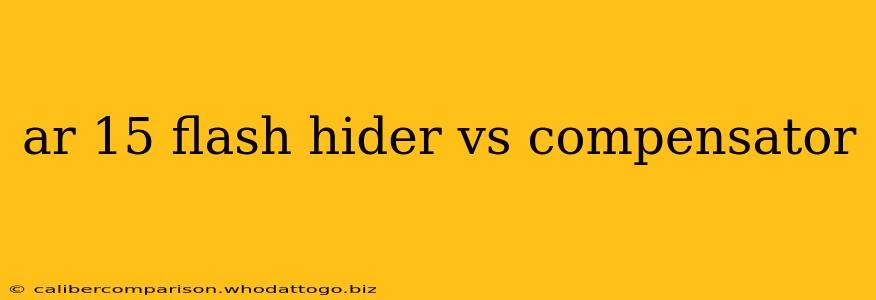Choosing the right muzzle device for your AR-15 can significantly impact its performance and handling. Two popular options are flash hiders and compensators, each designed to address specific shooter needs. While they might look similar at first glance, their functions and benefits differ considerably. This guide will delve into the key distinctions between AR-15 flash hiders and compensators, helping you make an informed decision based on your shooting style and priorities.
Understanding Flash Hiders
An AR-15 flash hider's primary function is to reduce the visible muzzle flash produced when firing. This is achieved through a series of baffles and vents strategically designed to redirect and dissipate the hot gases exiting the barrel. This is especially beneficial in low-light conditions where a bright flash can compromise the shooter's night vision and reveal their position.
Key Benefits of Flash Hiders:
- Reduced Muzzle Flash: The most significant advantage is the considerable reduction in visible muzzle flash, enhancing tactical stealth and situational awareness.
- Improved Night Vision: Minimizing flash is crucial for maintaining night vision, especially important for tactical or hunting applications.
- Some Sound Suppression: While not their primary function, some flash hiders offer a slight reduction in perceived sound, though dedicated suppressors are far more effective.
Limitations of Flash Hiders:
- Minimal Recoil Reduction: Flash hiders generally offer little to no recoil mitigation.
- Can be Bulky: Some flash hider designs can be larger and heavier than compensators.
Understanding Compensators
AR-15 compensators are primarily designed to mitigate recoil and improve muzzle rise. They achieve this by using ports and baffles to redirect propellant gases, counteracting the upward and sideways forces generated during firing. This leads to faster target reacquisition and improved accuracy, particularly during rapid fire.
Key Benefits of Compensators:
- Reduced Recoil: The most significant advantage is the noticeable reduction in felt recoil and muzzle climb, allowing for quicker follow-up shots.
- Improved Accuracy: By controlling recoil, compensators enhance accuracy, especially during rapid or sustained fire.
- Increased Controllability: The reduced recoil translates to better control and stability of the weapon, making it easier to manage.
Limitations of Compensators:
- Increased Muzzle Blast: Compensators can actually increase the perceived muzzle blast and sometimes flash, albeit often in a more controlled direction.
- May Increase Noise: Some shooters report a slight increase in perceived noise due to the redirection of gases.
Flash Hider vs. Compensator: A Direct Comparison
| Feature | Flash Hider | Compensator |
|---|---|---|
| Primary Function | Reduce Muzzle Flash | Reduce Recoil & Muzzle Rise |
| Recoil Reduction | Minimal | Significant |
| Muzzle Flash | Significantly Reduced | May be Increased or Slightly Reduced |
| Accuracy | Slightly Improved (due to reduced flash distraction) | Significantly Improved |
| Sound | Slight reduction possible | May be slightly increased |
| Size/Weight | Can be bulky | Generally more compact and lighter |
Which Muzzle Device is Right for You?
The best choice depends entirely on your priorities:
- Prioritize stealth and low light conditions? Choose a flash hider.
- Prioritize recoil reduction and accuracy during rapid fire? Choose a compensator.
Some advanced muzzle devices even combine elements of both flash hiders and compensators, offering a compromise between flash reduction and recoil mitigation. Ultimately, the optimal choice requires considering your individual shooting style, environment, and specific needs. Experimentation and personal preference play a significant role in determining the best muzzle device for your AR-15.

